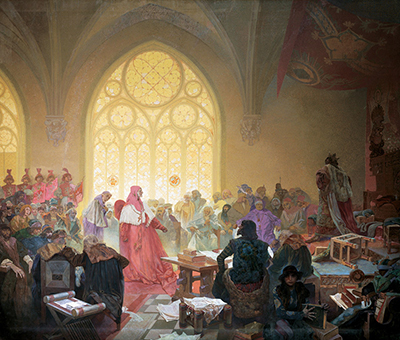The Hussite King Jiří z Podĕbrad was completed by Czech painter Alphonse Mucha in 1923 and covers a period of Slavic history in around the 15th century.
The content in front of us explains the current state of affairs for the slavs during the 15th century. There would be a Bohemian native king elected in the middle of the century which marked a growing strength and autonomy within the region. His name was King Jiří z Podĕbrad who can be found within this painting - it was the thirteenth of twenty within the Slav Epic series. The King would start to achieve a more balanced relationship with Rome for the first time, and visit them occasionally but eventually Rome would resist their growing strength and try to force them to desist in these attempts towards greater autonomy. Ultimately, a visitor from Rome would cause great offence in person to the King within this painting by making unreasonable demands, hence the items of furniture which he has strewn across the room. Essentially, Mucha here is marking the end of the relationship within this artwork.
The Slav Epic consistently tells us about the battles between the Slavic people and an aggressive form of Catholicism which continues on for many centuries. Much of the challenge in this regard would emanate from German regions, whilst the Slavs were keen to follow a more independent path. On occasion they would team up with other powers in the region in order to protect themselves. Italy would always be consulted with regards these disagreements over religious interpretation and the influence of Rome appears again within this painting. There are so many elements of European history to discover within this series of paintings, making it educational as well as artistically highly impressive. Mucha was naturally biased towards painting the history of his people in as flattering a way as possible, but he would also touch on difficult topics within the twenty artworks.
So within this iteration it was not Germanic regions which threatened the slavs, but actually the will of Rome to disallow their self-determination. The slavs were no-longer willing to accept these demands are were starting to display a greater confidence in their own identity. Besides the historical significance of this painting, the most memorable part of it would probably have to be the stunning window architecture found in the background which allows light to flood in and direct our eyes to the key figures within this scene. There is also a clear stand off which is carefully crafted by the artist, who purposely places the king in a higher position within the painting than his Roman visitor.




